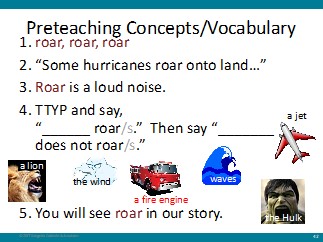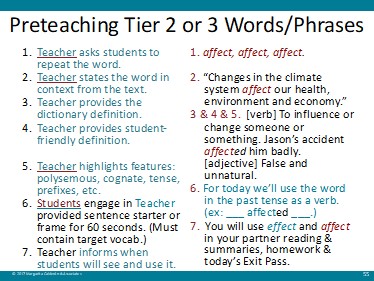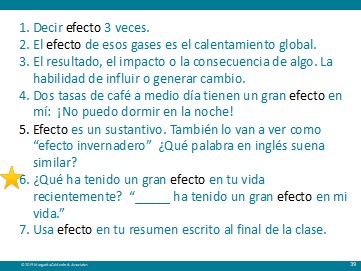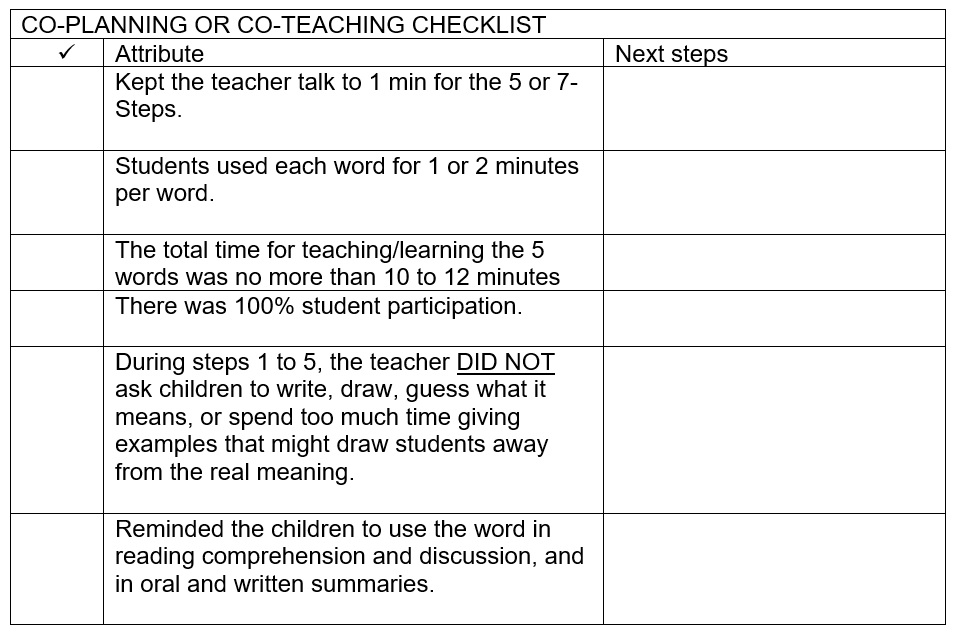by Dr. Margarita Calderón, creator of ExC-ELL
It is quite exciting to see that many teachers, not just ESL/ELD teachers, are interested in teaching more vocabulary. As I visit classrooms, I find many ways that teachers in K-5 teach vocabulary. While it is important to give more precedence to vocabulary, it is more important to consider “why” and “how” it is to be taught. Otherwise, the teaching of words becomes just a fun activity or takes up so much time that children do not have enough time on reading. Moreover, with some vocabulary techniques, students soon forget their meaning and do not use the new words. Thus, teachers find they have to reteach those words. Let’s take a look at some points of departure for school discussions and planning.
WHY? What’s vocabulary got to do with this?
Listening, speaking, reading and writing are the pillars of language and literacy development in one or two languages simultaneously. The more words children learn in K-2nd the faster they learn to speak, listen, discuss, read and write. Researchers have told us for quite some time that the vocabulary children know and are reading at grade level by 1st grade predicts how well they will be performing in middle and high school. In other words, their active verbal repertoire and reading fluency and comprehension are predictors of reading difficulties or no reading difficulties in later years.
- Vocabulary in kindergarten and first grade is a significant predictor of reading comprehension in the middle and secondary grades or reading difficulties (Cunningham & Stanovich, 1998; Chall & Dale, 1995; National Reading Panel, 2000).
- The average 6-year-old has a vocabulary of approximately 8,000 words and learns 3,000-5,000 more per year (Senechal & Cornell, 1993).
- By the end of 12th grade students should have learned 50,000 words (Graves, August, Carlo, 2011).
The researchers tell us that every child needs to master 3,000 to 5,000 words per year in school. Some children are fortunate enough to learn hundreds of words at home, yet, we know that many others will have to learn those in school. Nevertheless, the “how” section below provides some ideas for engaging the parents as teachers of vocabulary at home.
HOW? How can every ESL/ELD and general education teacher practice effective but efficient ways of teaching vocabulary?
Effective vocabulary instruction begins with careful planning and it is efficient when it takes only 2 minutes per word. There are several steps in planning a lesson and steps for Preteaching key words before Shared Reading, Guided Reading, Partner Reading, and even Silent Reading if that is a school policy. Albeit, silent reading is not an effective strategy for English Learners or any second-language learner unless it is for rereading a book teacher and student have already read and processed for comprehension. Otherwise, the student will resort to pretend reading and fossilize bad habit of pseudo-reading.
Lesson Planning.
When you select a book for any kind of reading, first parse it to determine where you need to chunk the book for:
- Finding words, phrases or clusters of words to preteach before reading (for example: shallow, deep end, over the course of). Select those you want to hear as they verbally summarize, use in discussions or you want to see in their follow-up writing activities. Narrow your list to 5 words.
- Finding words that can be taught on-the-run as reading begins. The students will either ask or you will notice that they need a quick definition. These can be taught with gestures, book illustrations, or a simple translation.
- Finding complex or long sentences that might have to be singled out. Once you deconstruct the sentence, construct it again and ask the students to use a similar sentence structure in their writing later on.
Teaching Vocabulary Before Reading.
You can preteach the 5 words you selected in 10 minutes before the students read or you read to the students. Teaching a word using the 7 steps should only take 2 minutes: one minute for the teacher’s steps 1 to 5 and one minute for the students to practice using the word with a partner. Step number 7 should only take a couple of seconds. For Kindergarten and the beginning of 1st grade, you can use only 5 steps as shown below. For 2nd grade and higher, teachers use the 7 steps.
FOR K AND 1ST GRADE:

FOR 2ND TO 12TH GRADES:

AN EXAMPLE IN SPANISH:

Our on-going research (Calderón, 2007, 2009, 2019) has shown the following sequence that connects vocabulary to reading, writing and content mastery:
Vocabulary knowledge correlates with reading comprehension.
↓
Reading comprehension correlates with academic writing.
↓
Reading comprehension and text-based writing correlates with procedural content knowledge.
↓
Content knowledge correlates with academic success and grade-level achievement.
Peer Coaching or Co-Teaching.
It is always nice to have a trusted buddy to help us plan or to give us feedback on our delivery during those first few trials. One way to ease into mastering quality implementation is to plan together, particularly for step 6. The frame we provide for students to practice has to be fail proof. That means, we should test it out loud first, ideally with a colleague. See if each one of you can come up with at least 6 examples with that frame as you ping-pong back and forth for a minute.
Another effective way to work with a colleague is to ask each other to observe how you do the 7 steps using this checklist.

Some Things to Remember:
(1) that comprehension depends on knowing between 90% and 95% of the words in text. Nevertheless, those first 5 words will help children enter the text with sufficient comprehension and greater possibilities to learn more words as they read or listen to the teacher read. (2) Knowing words means explicit instruction through the 5 or 7 steps, not just exposure. Students need 12 production opportunities with a partner as they take turns giving examples for one minute, to own a word. Each one provides 6 examples (receptive and productive vocabulary or listening and speaking skills development). (3) Avoid using methods that take up to 20 minutes to teach one or a few words. (4) Reading is the main goal for all! The Word/phrase came from the book to be read, NOT an isolated word. (5) Do not ask students to look up the word in a dictionary, they usually get the wrong definition and it takes them a long time to do so.
THEIR REWARD:
When a teacher teaches 5 words per subject area (e.g., math, science, social studies, ELA, ESL/ELD), students will master 20 to 25 words a day, 125 words per week, and around 3,000 to 5,000 a year.
YOUR REWARD:
All students, English Learners in particular, will be reading at grade level, learning patterns of academic writing, and doing so much better on all exams.
YOUR SCHOOL’S REWARD:
Will attain exemplary status, and better yet, will not send Long-Term ELs to middle schools.
REFERENCES
Chall, J. S. (1996). American reading achievement: Should we worry? Research in the Teaching of English, 30, 303–310.
Calderón, M. E. (2007). Teaching reading to English language learners, Grades 6-12: A framework for improving achievement in the content areas. Thousand Oaks, CA: Corwin Press.
Calderón, M.E. (2009). Language, literacy and knowledge for ELLs. In Better: Evidence-based Education. Spring, 14-15.
Calderón, M. E., Espino, G. & S. Slakk. (2019). Integrando lenguaje, lectura, escritura y contenidos en español e inglés. Integrating Language, Reading, Writing and Content in English and in Spanish. Los Angeles: Velazquez Press. https://velazquezpress.com/collections/bilingual-dual-language/products/integrando-lenguaje-lectura-ecritura-y-contenidos-en-espanol-e-ingles-integrating-language-reading-writing-and-content-in-english-and-spanish
Cunningham, A. E., & Stanovich, K. E. (1998). What reading does for the mind. American Educator, Spring-Summer, 8–17.
Graves, M., August, D. & Carlo, M. (2011). Teaching 50,000 words: Evidence-based education. In Better: Evidence-based Education. Winter, 5-6.
National Reading Panel (U.S.) & National Institute of Child Health and Human Development (U.S.). (2000). Report of the National Reading Panel teaching children to read: an evidence-based assessment of the scientific research literature on reading and its implications for reading instruction.